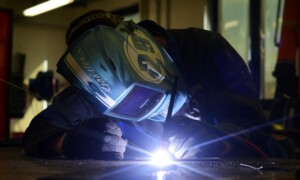 I am in the lucky position of seeing a lot of different shop floors through my work. This requires me to quickly understand what is going on on the shop floor and to estimate how well the shop floor is managed. What my hosts tell me and what I see unfortunately does not always match. In this series of posts I would like to go through my steps for understanding the shop floor to form my own opinion on the production system.
I am in the lucky position of seeing a lot of different shop floors through my work. This requires me to quickly understand what is going on on the shop floor and to estimate how well the shop floor is managed. What my hosts tell me and what I see unfortunately does not always match. In this series of posts I would like to go through my steps for understanding the shop floor to form my own opinion on the production system.
Introduction
 The way you’re seeing the shop floor depends a lot on your function. A shop floor manager who spends a lot of his time in one section of the shop floor has different needs for understanding the shop floor than the plant manager, who visits the shop floor only daily and then often visits different areas of a potentially large plant. A section manager or CXO in charge of multiple plants may still know the basic whereabouts of each plant, but is able to visit them only irregularly, sometimes with months in between visits. An external consultant has never seen the plant before.
The way you’re seeing the shop floor depends a lot on your function. A shop floor manager who spends a lot of his time in one section of the shop floor has different needs for understanding the shop floor than the plant manager, who visits the shop floor only daily and then often visits different areas of a potentially large plant. A section manager or CXO in charge of multiple plants may still know the basic whereabouts of each plant, but is able to visit them only irregularly, sometimes with months in between visits. An external consultant has never seen the plant before.
 Hence, you have a lot of different levels of prior knowledge of the plant depending on the person. For someone rather or completely new to the plant, a value stream map and a layout can help provide a rough overview of what is happening and where. A shop floor manager, however, needs a value stream map or a layout only if he wants to move things around or change the material and information flow. The shop floor manager has (hopefully) a good understanding of all processes in his care. On the other hand, a CEO does not need to know the details of all the processes, but merely wants to get a feel on how well the shop floor is managed based on some sample observations. The CEO or consultant may also focus on a few processes as part of a project or the verification of a completed project. Hence, not only does the prior knowledge differ, but also the level of detail needed for the observations.
Hence, you have a lot of different levels of prior knowledge of the plant depending on the person. For someone rather or completely new to the plant, a value stream map and a layout can help provide a rough overview of what is happening and where. A shop floor manager, however, needs a value stream map or a layout only if he wants to move things around or change the material and information flow. The shop floor manager has (hopefully) a good understanding of all processes in his care. On the other hand, a CEO does not need to know the details of all the processes, but merely wants to get a feel on how well the shop floor is managed based on some sample observations. The CEO or consultant may also focus on a few processes as part of a project or the verification of a completed project. Hence, not only does the prior knowledge differ, but also the level of detail needed for the observations.
General Advice
In my view, there are a few common mistakes when visiting a shop floor. As mentioned in previous posts, your host may not always be interested in showing you the true situation on the shop floor, but rather a prettified version with lots of makeup. Hence, it is imperative to at least occasionally go to the shop floor yourself and verify the true situation in production.
Avoid Technical Details
 When visiting the shop floor, one thing I am a bit susceptible to are technical details. As a German engineer, I love observing a milling machine, find lathes just beautiful, am excited by welding, and adore any type of casting. Hence, I am very interested in how the process works. Unfortunately, by doing so I get lost in the fine details and miss out on the big picture. I have to force myself to take a step back, ignore the (oh-so-exciting) technical details, and focus more on the surrounding processes of the information and the material flow.
When visiting the shop floor, one thing I am a bit susceptible to are technical details. As a German engineer, I love observing a milling machine, find lathes just beautiful, am excited by welding, and adore any type of casting. Hence, I am very interested in how the process works. Unfortunately, by doing so I get lost in the fine details and miss out on the big picture. I have to force myself to take a step back, ignore the (oh-so-exciting) technical details, and focus more on the surrounding processes of the information and the material flow.
As a lean expert, I am not here to improve the technical details of the welding, but rather the organizational details that support the welding (or other) process. Hence, do not get lost in the technical details unless it is necessary for your project. My host is often equally excited to tell me about the details of the technology, but I have to politely slow him down and focus our attention on the topic at hand.
Focus on Core Areas
 Second, as you can get lost in technical details, you can get lost in a large plant with many different sections and buildings. Often, my host, proud of his plant, wants to show me everything from A to Z. And if I give in to that, I get a two-hour tour from one end of the plant to the other. I see a lot of (usually green) machines, but know little on how well they are run or how they are organized. Besides, I find that after ninety minutes of focusing on the shop floor, my mind needs a break. Hence, here, too, I have to politely guide my host to show me only a selection of the areas, rather than everything. I much rather prefer to focus on a few core areas in detail rather than see everything briefly.
Second, as you can get lost in technical details, you can get lost in a large plant with many different sections and buildings. Often, my host, proud of his plant, wants to show me everything from A to Z. And if I give in to that, I get a two-hour tour from one end of the plant to the other. I see a lot of (usually green) machines, but know little on how well they are run or how they are organized. Besides, I find that after ninety minutes of focusing on the shop floor, my mind needs a break. Hence, here, too, I have to politely guide my host to show me only a selection of the areas, rather than everything. I much rather prefer to focus on a few core areas in detail rather than see everything briefly.
What you focus on depends a lot on why you are visiting the plant. If I merely want to understand how well the plant is organized, I have a look at the most important part of the plant. This is often the last segment of the value stream (e.g., the final assembly line) for a high-runner product. However, for a full picture I also want to see one or two sub-assemblies or preceding areas of the value stream. This way I also see some areas that may not get as much management attention as the final assembly line.
Have Time to See and Think
 Understanding the shop floor needs a bit of time and your own thoughts. If another person gives you an explanation, then this person is guiding your thoughts. That can be helpful, especially at the beginning. However, I also need time to think for myself, at which point a conversation with someone else would be distracting. Similar to Taiichi Ohno’s chalk circle, I need some time just to observe on my own. Depending on the plant and the situation, this may be most difficult for your hosts to accept.
Understanding the shop floor needs a bit of time and your own thoughts. If another person gives you an explanation, then this person is guiding your thoughts. That can be helpful, especially at the beginning. However, I also need time to think for myself, at which point a conversation with someone else would be distracting. Similar to Taiichi Ohno’s chalk circle, I need some time just to observe on my own. Depending on the plant and the situation, this may be most difficult for your hosts to accept.
Don’t Try to See Everything
 Finally, don’t try to see everything at the same time. Nor is it necessarily helpful to just go and see what you see. I personally find it most useful to focus on certain aspects of a shop floor, and only one at a given time. These different aspects are for me usually the following:
Finally, don’t try to see everything at the same time. Nor is it necessarily helpful to just go and see what you see. I personally find it most useful to focus on certain aspects of a shop floor, and only one at a given time. These different aspects are for me usually the following:
- Visual Management and 5S: How clean and orderly does everything look? Is it easy to understand? Can you see the information flow too?
- Looking for Waste: This is probably the easiest, as it is not difficult to see the seven types of waste.
- Unevenness: This is tougher, as you have to observe multiple cycles to see unevenness in a process.
- Overburden: Maybe hardest to see, but most relevant.
- Safety: Would actually belong to overburden, but I often try to see it separately due to its significance.
Seeing on the shop floor is important, but data should also not be neglected. Hence, it may also make sense to look at data related to the shop floor as needed. But beware of pitfalls in using data.
I will go in much more detail in subsequent posts on each of these aspects when observing the shop floor. Now, go out, look at your gemba, and organize your industry!

what about focus on the bottleneck section or process? seeing the countermeasures taken at bottleneck to know the plant in a limited time.
Hi Feng, very often it is not “THE bottleneck process”, but a constantly changing and shifting bottleneck. Very often, this is not really known to management, despite them believing otherwise. I have a lot of posts on bottlenecks, since it is one of my core areas of expertise.